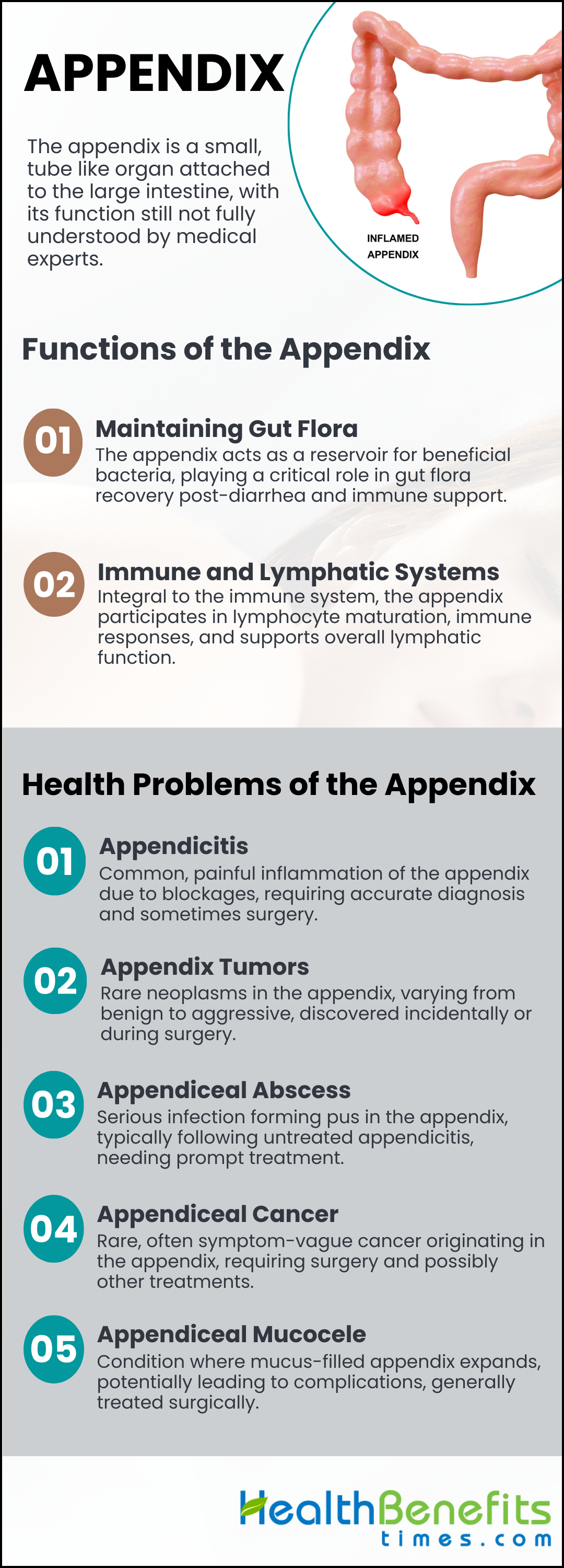The appendix, traditionally considered a vestigial organ with no significant function, has emerged through recent research as an organ of notable importance in the human body. It is part of the gut-associated lymphoid tissue (GALT), playing a pivotal role in the immune system by housing antigen-presenting cells like dendritic cells and M cells, which are essential for the mucosal immune response. This re-evaluation of the appendix’s role underscores its involvements in the body’s defense mechanisms, extremely in the gastrointestinal tract.
Structure of Appendix
The appendix is a very small, tube-shaped pouch attached to the cecum, which is the first part of the large intestine. It is located in the lower right quadrant of the abdomen. The appendix is often about 3 to 4 inches long and has a diameter of about 1/4 inch. It is constituted of various layers, including an outer layer of smooth muscle, a submucosa layer containing lymphoid tissue, and an inner mucosal layer lined with columnar epithelial cells. The submucosa layer includes a high concentration of lymphoid follicles, that are the part of the body’s immune system and may play a role in gut immunity. The exact function of the appendix is still not fully understood; however, it is believed to have some immune-related functions and may serve as a reservoir for advantageous gut bacteria. Despite its potential roles, the appendix is not necessary for survival, and its removal (appendectomy) is a common surgical procedure performed in cases of appendicitis.
Functions of the Appendix
In recent research it has shed light on its important role in the human body. The functions of the appendix involve contributing to the immune system, housing beneficial bacteria, and probably serving as a reservoir for gut flora.
1. Maintaining gut flora
It plays a pivotal role in maintaining gut flora by acting as a safe-house for commensal bacteria and contributing importantly to the host’s immune system and homeostasis. The unique microbial composition harbored in the appendix, distinct from the large bowel, supports the development of primary antibodies and the maturation of immune cells, facilitating the re-inoculation of the gut with beneficial bacteria following disturbances. This function is particularly important in environments lacking modern hygiene and medical practices, where the preservation of intestinal biodiversity by the appendix becomes essential for host survival. The evolutionary history of the appendix, which has independently progress multiple times across several mammalian species, underscores its adaptive advantage and the importance of its immunological functions.
2. Immune and lymphatic systems
The human appendix, traditionally considered a vestigial organ, plays a significant role in both the immune and lymphatic systems. It serves as a key component of gut-associated lymphoid tissue (GALT) and also contributes to the body’s defense mechanisms by housing antigen-presenting cells, like dendritic cells and M cells, that are crucial for initiating immune responses within the mucosal immune system. This confirms its status as a secondary lymphoid organ. The appendix is involved in the maturation and activation of lymphocytes, which are primary effector cells of the immune system, emphasizing its integral role in immune surveillance and response. The lymphoid tissue of the appendix undergoes critical developmental stages during prenatal ontogenesis, indicating its early involvement in the body’s immune functions.
Health Problems of the Appendix
The appendix, despite its small size and seemingly insignificant nature, can sometimes be the source of significant health problems. There are some health problems that can affect the appendix as well, like appendiceal tumors and appendiceal abscesses. In this article, we will delve into these health problems of the appendix, exploring their causes, symptoms, and available treatment options. By understanding these conditions, we can better appreciate the importance of maintaining the health of this organ.
1. Appendicitis
Appendicitis is a common medical condition that affects the appendix, characterized by inflammation often caused by blockage in the appendix, leading to a range of symptoms like abdominal pain, nausea, and fever. Various factors can contribute to this blockage, including fecal stones, lymphoid hyperplasia, foreign bodies, and infections, with E. Coli and Streptococcus being common bacterial causes. Unusual causes like viral infections, parasites, and neoplasms have also been reported, demonstrating the diverse causes of appendicitis and the importance of examining tissue samples after surgery. The global impact of appendicitis and its complications, like surgical site infections, varies depending on region, socioeconomic status, and healthcare spending.
While disability-adjusted life years have decreased over time, developing countries still face challenges due to inconsistent definitions of surgical site infections. Recurrent appendicitis, although rare, can occur due to partial or temporary blockages in the appendix. Diagnosis relies on clinical signs, laboratory tests, and imaging, with the Alvarado and Pediatric Appendicitis Scores helping to assess risk. Appendicitis can be mistaken for other conditions, emphasizing the importance of accurate diagnosis to prevent serious complications or death. The management of appendicitis has advanced, with a decrease in unnecessary surgeries achieved through a comprehensive approach to diagnosis and treatment that includes clinical criteria, imaging, and laboratory tests.
2. Appendix Tumors
Appendiceal tumors are a rare and diverse group of neoplasms with varying prognoses and treatment strategies. They are often found incidentally during appendectomies. These tumors can range from benign lesions, like granular cell tumors, to more assertive forms like adenocarcinomas and goblet cell adenocarcinomas, that may require extensive surgical intervention and chemotherapy in advanced stages. Neuroendocrine tumors of the appendix, even though relatively common among appendiceal tumors, present a management challenge because of their heterogeneous nature, with treatment options differing crucially based on the tumor’s grade and risk factors for metastasis.
The occurrence of collision tumors, where 2 distinct types of tumors coexist in the appendix, further complicates diagnosis and underscores the importance of thorough histological examination. Moreover, the unique tumor microenvironment of the appendix, rich in enteroendocrine cells and immunocompetent cells, plays a crucial role in the development and progression of these neoplasms.
3. Appendiceal abscess
An appendiceal abscess is a serious condition that occurs when the appendix becomes infected and forms a pocket of pus. It is often a complication of untreated or delayed treatment of appendicitis. The abscess typically develops as a result of the body’s immune response to the infection, leading to localized inflammation and the accumulation of pus.
The symptoms of an appendiceal abscess can vary but commonly include severe abdominal pain, tenderness, and fever. Other symptoms may include nausea, vomiting, and a general feeling of illness. In some cases, the abscess may cause a palpable mass in the lower right abdomen.
Prompt medical intervention is crucial in managing an appendiceal abscess. The treatment usually involves draining the abscess and administering appropriate antibiotics to control the infection. This can be done through a procedure called percutaneous drainage, where a needle or catheter is inserted into the abscess to remove the pus. In more severe cases, surgical intervention may be necessary to remove the abscess and potentially the appendix itself.
Early detection and treatment of an appendiceal abscess are essential to prevent complications such as the spread of infection or the formation of an abdominal mass. Timely medical care can help alleviate symptoms, promote healing, and reduce the risk of further complications.
4. Appendiceal cancer (including adenocarcinoma)
Appendiceal cancer is a rare type of cancer that originates in the appendix, a small organ located at the junction of the small and large intestines. This form of cancer is relatively uncommon and often presents with nonspecific symptoms, which can make it challenging to diagnose. The exact causes of appendiceal cancer are not well understood, but certain risk factors have been identified, including a family history of gastrointestinal cancers, genetic syndromes, and underlying inflammatory conditions such as Crohn’s disease or ulcerative colitis.
The symptoms of appendiceal cancer can vary, but they may include abdominal pain, changes in bowel habits, unexplained weight loss, and a mass or swelling in the lower right abdomen. Due to the vague nature of these symptoms, appendiceal cancer is often misdiagnosed or discovered incidentally during surgery for other conditions.
Treatment for appendiceal cancer typically involves surgery to remove the appendix, as well as any affected surrounding tissues. In some cases, additional treatments such as chemotherapy or radiation therapy may be recommended to target any remaining cancer cells or prevent the spread of the disease. Due to the rarity of appendiceal cancer, it is important for individuals experiencing persistent or concerning symptoms to seek medical attention for proper evaluation and diagnosis. Early detection and treatment can significantly improve the prognosis and outcomes for patients with appendiceal cancer.
5. Appendiceal mucocele
Appendiceal Mucocele occurs when the opening of the appendix becomes blocked, preventing the normal flow of mucus out of the organ. As a result, the appendix fills with mucus, causing it to expand and form a mucocele. Appendiceal mucoceles are often discovered incidentally during imaging tests or surgery for other conditions, as they typically do not present with specific symptoms. However, in some cases, individuals may experience abdominal pain or discomfort in the lower right side of the abdomen.
There are several types of appendiceal mucoceles, including simple mucoceles, mucinous cystadenomas, and mucinous cystadenocarcinomas. While most mucoceles are benign, some can be precancerous or cancerous. Therefore, it is important to accurately diagnose and evaluate the type of mucocele to determine the appropriate treatment approach.
Treatment for appendiceal mucoceles typically involves surgical removal of the appendix. This is done to prevent potential complications, as rupture or the development of cancer. In cases where the mucocele is found to be cancerous, additional treatment options, such as chemotherapy or further surgery, may be recommended.



